OPEL KARL 2015 Owners Manual
Manufacturer: OPEL, Model Year: 2015, Model line: KARL, Model: OPEL KARL 2015Pages: 217, PDF Size: 4.16 MB
Page 171 of 217
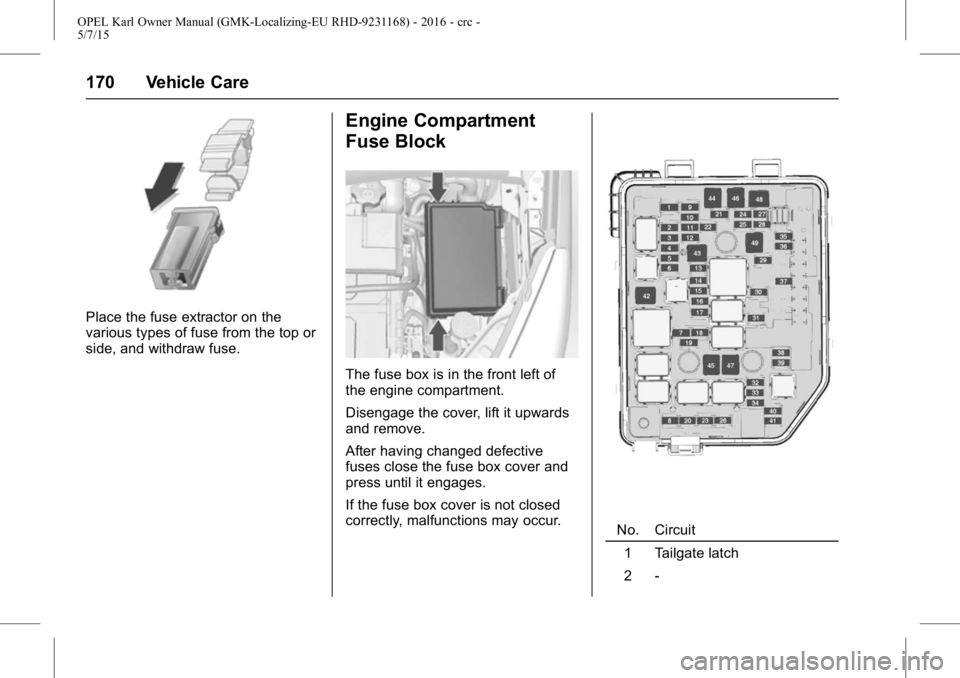
OPEL Karl Owner Manual (GMK-Localizing-EU RHD-9231168) - 2016 - crc -
5/7/15
170 Vehicle Care
Place the fuse extractor on the
various types of fuse from the top or
side, and withdraw fuse.
Engine Compartment
Fuse Block
The fuse box is in the front left of
the engine compartment.
Disengage the cover, lift it upwards
and remove.
After having changed defective
fuses close the fuse box cover and
press until it engages.
If the fuse box cover is not closed
correctly, malfunctions may occur.
No. Circuit1 Tailgate latch
2 -
Page 172 of 217
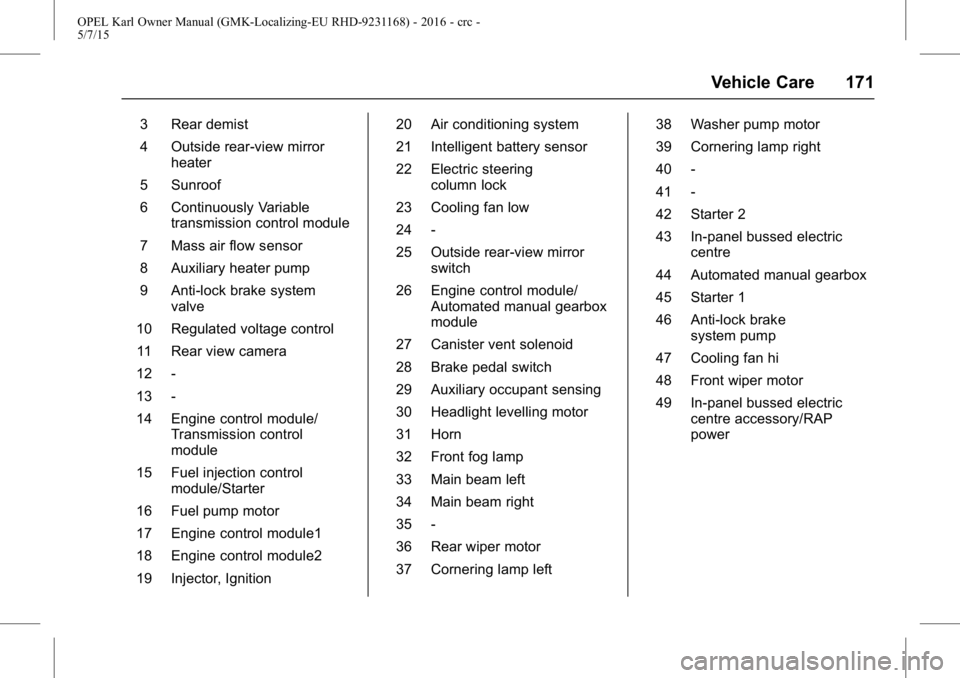
OPEL Karl Owner Manual (GMK-Localizing-EU RHD-9231168) - 2016 - crc -
5/7/15
Vehicle Care 171
3 Rear demist
4 Outside rear-view mirrorheater
5 Sunroof
6 Continuously Variable transmission control module
7 Mass air flow sensor
8 Auxiliary heater pump
9 Anti-lock brake system valve
10 Regulated voltage control 11 Rear view camera
12 -
13 -
14 Engine control module/ Transmission control
module
15 Fuel injection control module/Starter
16 Fuel pump motor
17 Engine control module1
18 Engine control module2
19 Injector, Ignition 20 Air conditioning system
21 Intelligent battery sensor
22 Electric steering
column lock
23 Cooling fan low
24 -
25 Outside rear-view mirror switch
26 Engine control module/ Automated manual gearbox
module
27 Canister vent solenoid
28 Brake pedal switch
29 Auxiliary occupant sensing
30 Headlight levelling motor
31 Horn
32 Front fog lamp
33 Main beam left
34 Main beam right
35 -
36 Rear wiper motor
37 Cornering lamp left 38 Washer pump motor
39 Cornering lamp right
40 -
41 -
42 Starter 2
43 In-panel bussed electric
centre
44 Automated manual gearbox
45 Starter 1
46 Anti-lock brake system pump
47 Cooling fan hi
48 Front wiper motor
49 In-panel bussed electric centre accessory/RAP
power
Page 173 of 217
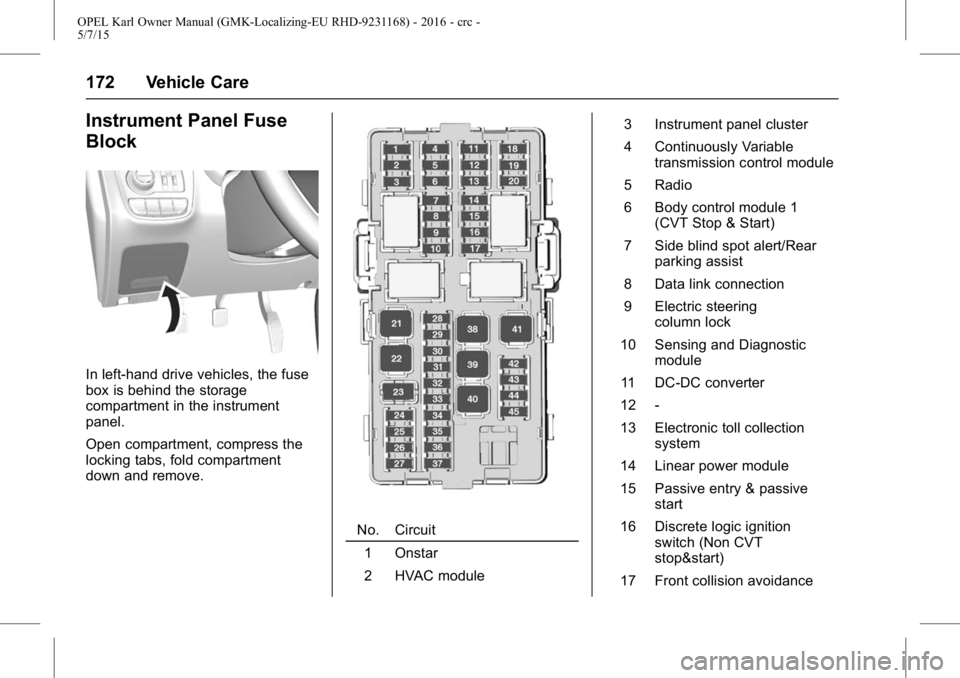
OPEL Karl Owner Manual (GMK-Localizing-EU RHD-9231168) - 2016 - crc -
5/7/15
172 Vehicle Care
Instrument Panel Fuse
Block
In left-hand drive vehicles, the fuse
box is behind the storage
compartment in the instrument
panel.
Open compartment, compress the
locking tabs, fold compartment
down and remove.
No. Circuit1 Onstar
2 HVAC module 3 Instrument panel cluster
4 Continuously Variable
transmission control module
5 Radio
6 Body control module 1 (CVT Stop & Start)
7 Side blind spot alert/Rear parking assist
8 Data link connection
9 Electric steering column lock
10 Sensing and Diagnostic module
11 DC-DC converter
12 -
13 Electronic toll collection system
14 Linear power module
15 Passive entry & passive start
16 Discrete logic ignition switch (Non CVT
stop&start)
17 Front collision avoidance
Page 174 of 217
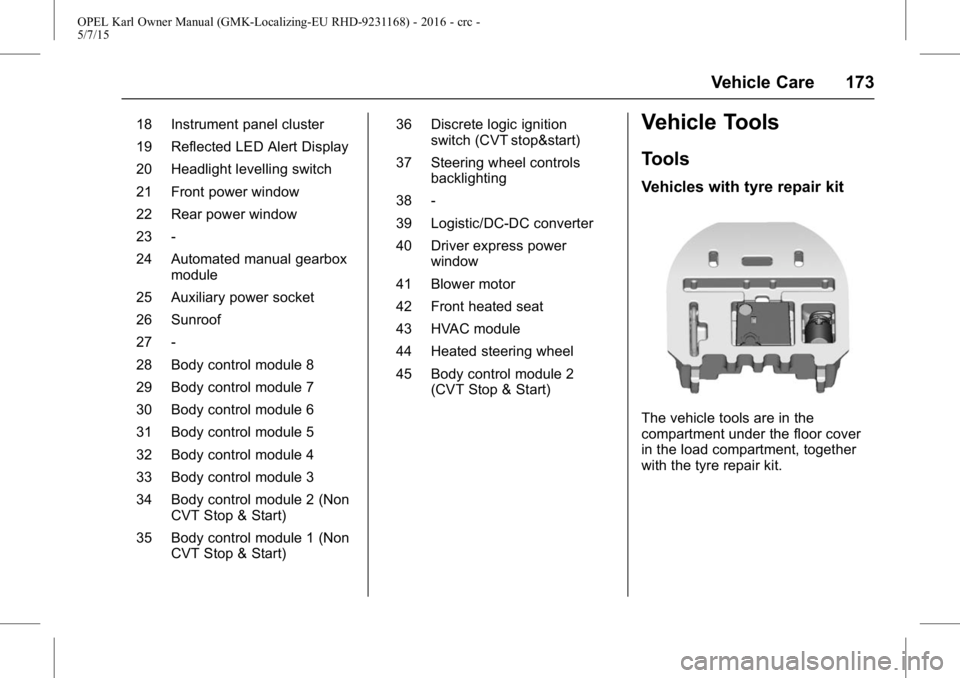
OPEL Karl Owner Manual (GMK-Localizing-EU RHD-9231168) - 2016 - crc -
5/7/15
Vehicle Care 173
18 Instrument panel cluster
19 Reflected LED Alert Display
20 Headlight levelling switch
21 Front power window
22 Rear power window
23 -
24 Automated manual gearboxmodule
25 Auxiliary power socket
26 Sunroof
27 -
28 Body control module 8
29 Body control module 7
30 Body control module 6
31 Body control module 5
32 Body control module 4
33 Body control module 3
34 Body control module 2 (Non CVT Stop & Start)
35 Body control module 1 (Non CVT Stop & Start) 36 Discrete logic ignition
switch (CVT stop&start)
37 Steering wheel controls backlighting
38 -
39 Logistic/DC-DC converter
40 Driver express power window
41 Blower motor
42 Front heated seat
43 HVAC module
44 Heated steering wheel
45 Body control module 2 (CVT Stop & Start)Vehicle Tools
Tools
Vehicles with tyre repair kit
The vehicle tools are in the
compartment under the floor cover
in the load compartment, together
with the tyre repair kit.
Page 175 of 217
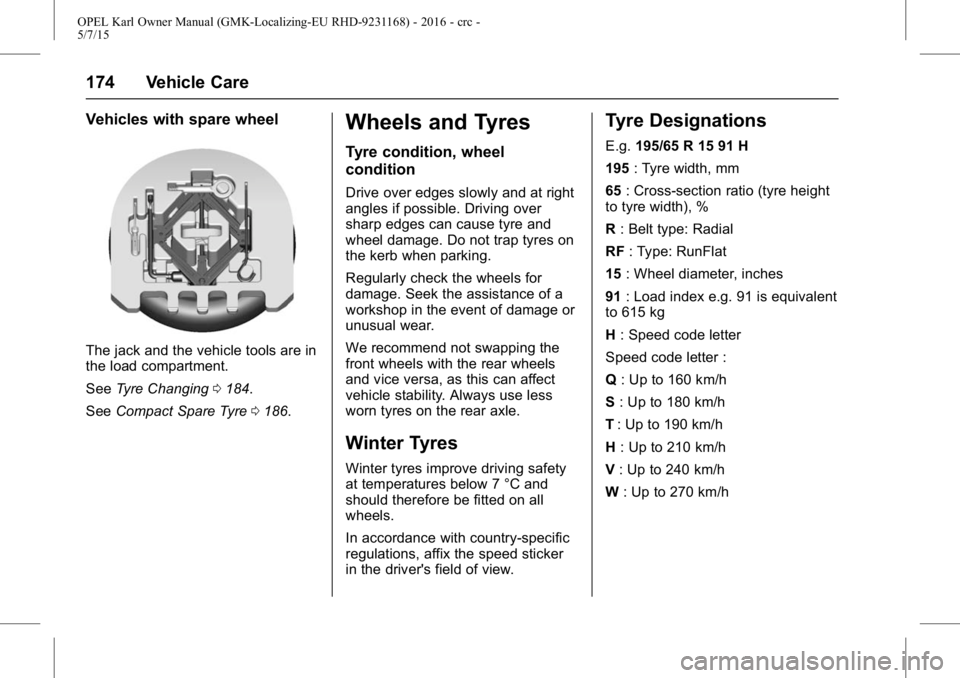
OPEL Karl Owner Manual (GMK-Localizing-EU RHD-9231168) - 2016 - crc -
5/7/15
174 Vehicle Care
Vehicles with spare wheel
The jack and the vehicle tools are in
the load compartment.
SeeTyre Changing 0184.
See Compact Spare Tyre 0186.
Wheels and Tyres
Tyre condition, wheel
condition
Drive over edges slowly and at right
angles if possible. Driving over
sharp edges can cause tyre and
wheel damage. Do not trap tyres on
the kerb when parking.
Regularly check the wheels for
damage. Seek the assistance of a
workshop in the event of damage or
unusual wear.
We recommend not swapping the
front wheels with the rear wheels
and vice versa, as this can affect
vehicle stability. Always use less
worn tyres on the rear axle.
Winter Tyres
Winter tyres improve driving safety
at temperatures below 7 °C and
should therefore be fitted on all
wheels.
In accordance with country-specific
regulations, affix the speed sticker
in the driver's field of view.
Tyre Designations
E.g. 195/65 R 15 91 H
195 : Tyre width, mm
65 : Cross-section ratio (tyre height
to tyre width), %
R : Belt type: Radial
RF : Type: RunFlat
15 : Wheel diameter, inches
91 : Load index e.g. 91 is equivalent
to 615 kg
H : Speed code letter
Speed code letter :
Q : Up to 160 km/h
S : Up to 180 km/h
T : Up to 190 km/h
H : Up to 210 km/h
V : Up to 240 km/h
W : Up to 270 km/h
Page 176 of 217
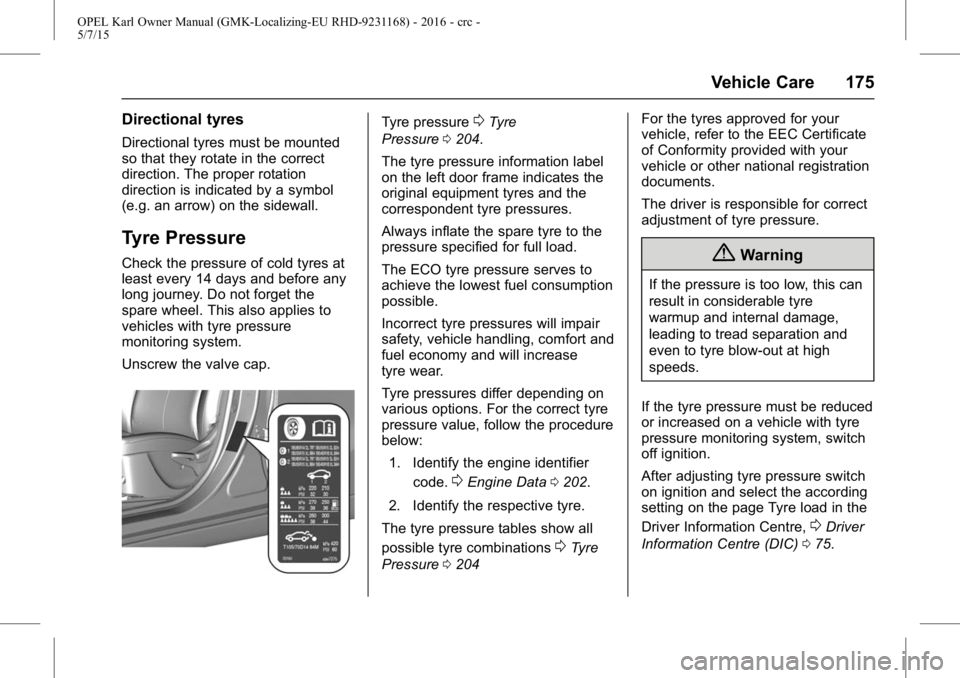
OPEL Karl Owner Manual (GMK-Localizing-EU RHD-9231168) - 2016 - crc -
5/7/15
Vehicle Care 175
Directional tyres
Directional tyres must be mounted
so that they rotate in the correct
direction. The proper rotation
direction is indicated by a symbol
(e.g. an arrow) on the sidewall.
Tyre Pressure
Check the pressure of cold tyres at
least every 14 days and before any
long journey. Do not forget the
spare wheel. This also applies to
vehicles with tyre pressure
monitoring system.
Unscrew the valve cap.
Tyre pressure0Tyre
Pressure 0204.
The tyre pressure information label
on the left door frame indicates the
original equipment tyres and the
correspondent tyre pressures.
Always inflate the spare tyre to the
pressure specified for full load.
The ECO tyre pressure serves to
achieve the lowest fuel consumption
possible.
Incorrect tyre pressures will impair
safety, vehicle handling, comfort and
fuel economy and will increase
tyre wear.
Tyre pressures differ depending on
various options. For the correct tyre
pressure value, follow the procedure
below: 1. Identify the engine identifier code.
0Engine Data 0202.
2. Identify the respective tyre.
The tyre pressure tables show all
possible tyre combinations
0Tyre
Pressure 0204 For the tyres approved for your
vehicle, refer to the EEC Certificate
of Conformity provided with your
vehicle or other national registration
documents.
The driver is responsible for correct
adjustment of tyre pressure.
{Warning
If the pressure is too low, this can
result in considerable tyre
warmup and internal damage,
leading to tread separation and
even to tyre blow-out at high
speeds.
If the tyre pressure must be reduced
or increased on a vehicle with tyre
pressure monitoring system, switch
off ignition.
After adjusting tyre pressure switch
on ignition and select the according
setting on the page Tyre load in the
Driver Information Centre,
0Driver
Information Centre (DIC) 075.
Page 177 of 217
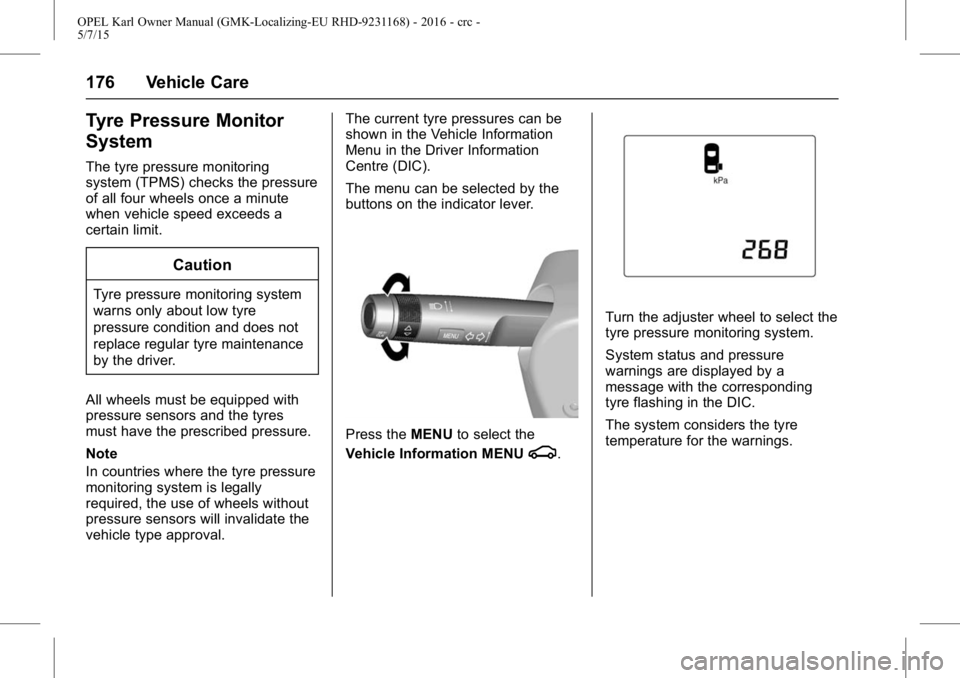
OPEL Karl Owner Manual (GMK-Localizing-EU RHD-9231168) - 2016 - crc -
5/7/15
176 Vehicle Care
Tyre Pressure Monitor
System
The tyre pressure monitoring
system (TPMS) checks the pressure
of all four wheels once a minute
when vehicle speed exceeds a
certain limit.
Caution
Tyre pressure monitoring system
warns only about low tyre
pressure condition and does not
replace regular tyre maintenance
by the driver.
All wheels must be equipped with
pressure sensors and the tyres
must have the prescribed pressure.
Note
In countries where the tyre pressure
monitoring system is legally
required, the use of wheels without
pressure sensors will invalidate the
vehicle type approval. The current tyre pressures can be
shown in the Vehicle Information
Menu in the Driver Information
Centre (DIC).
The menu can be selected by the
buttons on the indicator lever.
Press the
MENUto select the
Vehicle Information MENU
g.
Turn the adjuster wheel to select the
tyre pressure monitoring system.
System status and pressure
warnings are displayed by a
message with the corresponding
tyre flashing in the DIC.
The system considers the tyre
temperature for the warnings.
Page 178 of 217
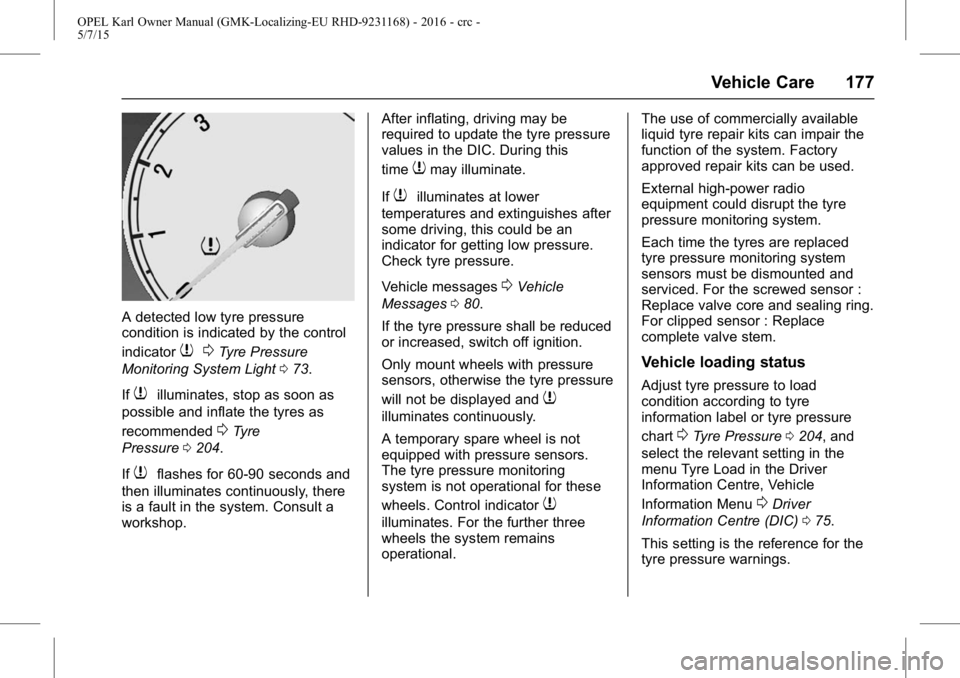
OPEL Karl Owner Manual (GMK-Localizing-EU RHD-9231168) - 2016 - crc -
5/7/15
Vehicle Care 177
A detected low tyre pressure
condition is indicated by the control
indicator
70Tyre Pressure
Monitoring System Light 073.
If
7illuminates, stop as soon as
possible and inflate the tyres as
recommended
0Tyre
Pressure 0204.
If
7flashes for 60-90 seconds and
then illuminates continuously, there
is a fault in the system. Consult a
workshop. After inflating, driving may be
required to update the tyre pressure
values in the DIC. During this
time
7may illuminate.
If
7illuminates at lower
temperatures and extinguishes after
some driving, this could be an
indicator for getting low pressure.
Check tyre pressure.
Vehicle messages
0Vehicle
Messages 080.
If the tyre pressure shall be reduced
or increased, switch off ignition.
Only mount wheels with pressure
sensors, otherwise the tyre pressure
will not be displayed and
7
illuminates continuously.
A temporary spare wheel is not
equipped with pressure sensors.
The tyre pressure monitoring
system is not operational for these
wheels. Control indicator
7
illuminates. For the further three
wheels the system remains
operational. The use of commercially available
liquid tyre repair kits can impair the
function of the system. Factory
approved repair kits can be used.
External high-power radio
equipment could disrupt the tyre
pressure monitoring system.
Each time the tyres are replaced
tyre pressure monitoring system
sensors must be dismounted and
serviced. For the screwed sensor :
Replace valve core and sealing ring.
For clipped sensor : Replace
complete valve stem.
Vehicle loading status
Adjust tyre pressure to load
condition according to tyre
information label or tyre pressure
chart
0Tyre Pressure
0204, and
select the relevant setting in the
menu Tyre Load in the Driver
Information Centre, Vehicle
Information Menu
0Driver
Information Centre (DIC) 075.
This setting is the reference for the
tyre pressure warnings.
Page 179 of 217
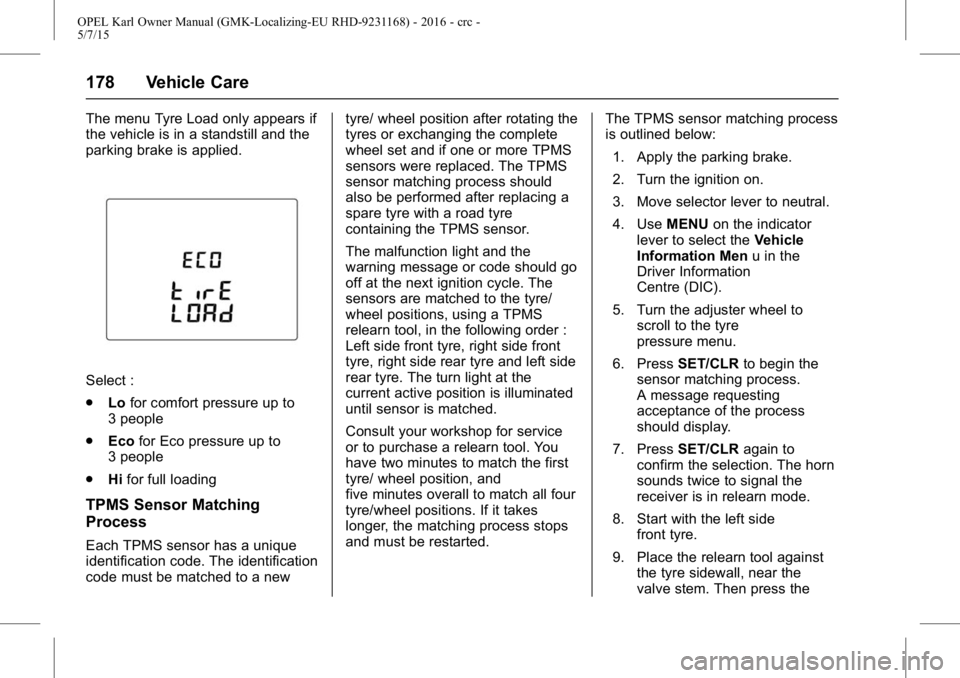
OPEL Karl Owner Manual (GMK-Localizing-EU RHD-9231168) - 2016 - crc -
5/7/15
178 Vehicle Care
The menu Tyre Load only appears if
the vehicle is in a standstill and the
parking brake is applied.
Select :
.Lofor comfort pressure up to
3 people
. Eco for Eco pressure up to
3 people
. Hifor full loading
TPMS Sensor Matching
Process
Each TPMS sensor has a unique
identification code. The identification
code must be matched to a new tyre/ wheel position after rotating the
tyres or exchanging the complete
wheel set and if one or more TPMS
sensors were replaced. The TPMS
sensor matching process should
also be performed after replacing a
spare tyre with a road tyre
containing the TPMS sensor.
The malfunction light and the
warning message or code should go
off at the next ignition cycle. The
sensors are matched to the tyre/
wheel positions, using a TPMS
relearn tool, in the following order :
Left side front tyre, right side front
tyre, right side rear tyre and left side
rear tyre. The turn light at the
current active position is illuminated
until sensor is matched.
Consult your workshop for service
or to purchase a relearn tool. You
have two minutes to match the first
tyre/ wheel position, and
five minutes overall to match all four
tyre/wheel positions. If it takes
longer, the matching process stops
and must be restarted.
The TPMS sensor matching process
is outlined below:
1. Apply the parking brake.
2. Turn the ignition on.
3. Move selector lever to neutral.
4. Use MENUon the indicator
lever to select the Vehicle
Information Men u in the
Driver Information
Centre (DIC).
5. Turn the adjuster wheel to scroll to the tyre
pressure menu.
6. Press SET/CLR to begin the
sensor matching process.
A message requesting
acceptance of the process
should display.
7. Press SET/CLR again to
confirm the selection. The horn
sounds twice to signal the
receiver is in relearn mode.
8. Start with the left side front tyre.
9. Place the relearn tool against the tyre sidewall, near the
valve stem. Then press the
Page 180 of 217
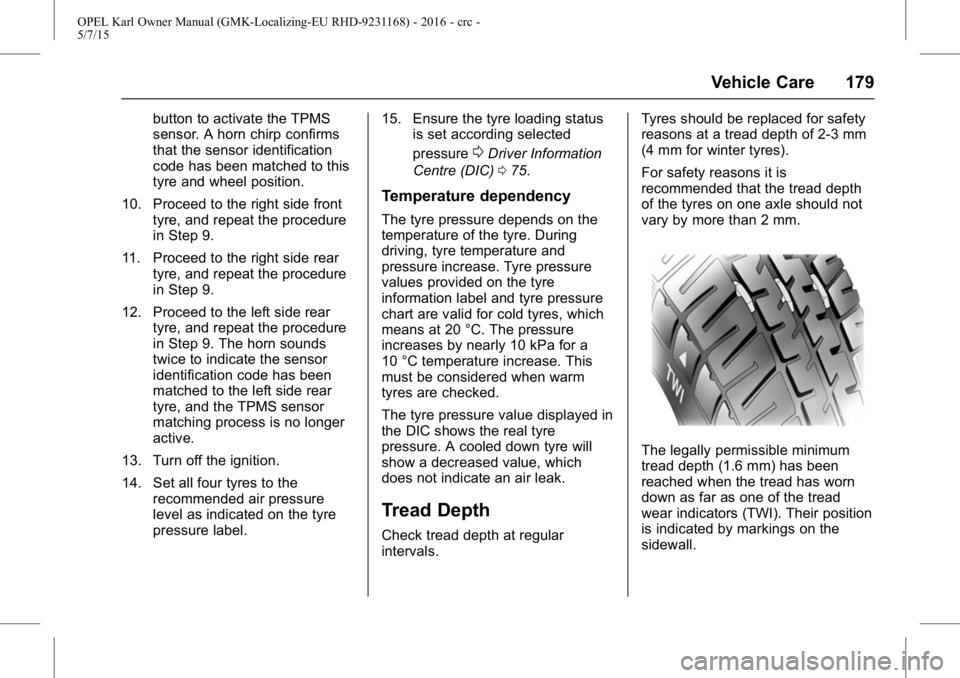
OPEL Karl Owner Manual (GMK-Localizing-EU RHD-9231168) - 2016 - crc -
5/7/15
Vehicle Care 179
button to activate the TPMS
sensor. A horn chirp confirms
that the sensor identification
code has been matched to this
tyre and wheel position.
10. Proceed to the right side front tyre, and repeat the procedure
in Step 9.
11. Proceed to the right side rear tyre, and repeat the procedure
in Step 9.
12. Proceed to the left side rear tyre, and repeat the procedure
in Step 9. The horn sounds
twice to indicate the sensor
identification code has been
matched to the left side rear
tyre, and the TPMS sensor
matching process is no longer
active.
13. Turn off the ignition.
14. Set all four tyres to the recommended air pressure
level as indicated on the tyre
pressure label. 15. Ensure the tyre loading status
is set according selected
pressure
0Driver Information
Centre (DIC) 075.
Temperature dependency
The tyre pressure depends on the
temperature of the tyre. During
driving, tyre temperature and
pressure increase. Tyre pressure
values provided on the tyre
information label and tyre pressure
chart are valid for cold tyres, which
means at 20 °C. The pressure
increases by nearly 10 kPa for a
10 °C temperature increase. This
must be considered when warm
tyres are checked.
The tyre pressure value displayed in
the DIC shows the real tyre
pressure. A cooled down tyre will
show a decreased value, which
does not indicate an air leak.
Tread Depth
Check tread depth at regular
intervals. Tyres should be replaced for safety
reasons at a tread depth of 2-3 mm
(4 mm for winter tyres).
For safety reasons it is
recommended that the tread depth
of the tyres on one axle should not
vary by more than 2 mm.
The legally permissible minimum
tread depth (1.6 mm) has been
reached when the tread has worn
down as far as one of the tread
wear indicators (TWI). Their position
is indicated by markings on the
sidewall.